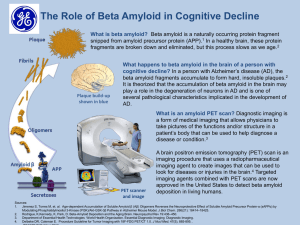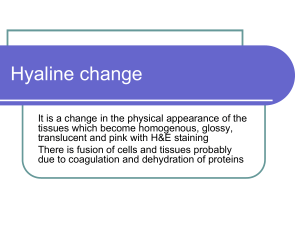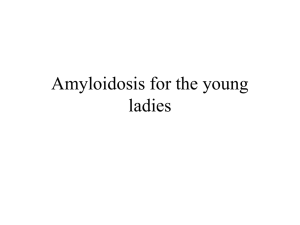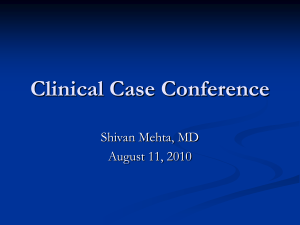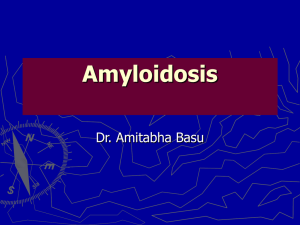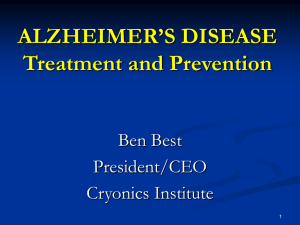challenging cases in the elderly — Neil Rabin
advertisement
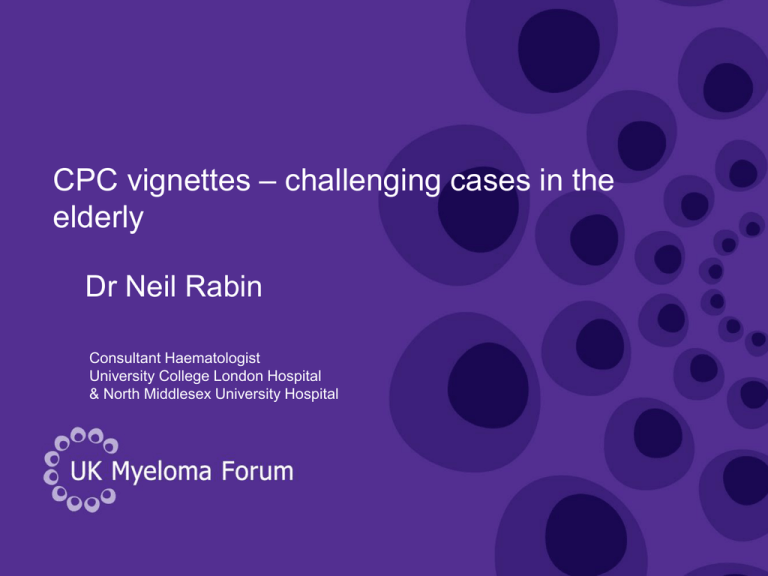
CPC vignettes – challenging cases in the elderly Dr Neil Rabin Consultant Haematologist University College London Hospital & North Middlesex University Hospital Case 1: William • • • • • • • • 70 year old retired biomedical scientist June 2007: weight loss and fatigue IgG lambda pp 44g/L, BJP negative Hypercalcaemia with normal renal function BM 80-90% plasma cells SS: multiple lytic lesions Cytogenetic – FISH - normal ISS stage: 2 • PMHx – Asthma, investigated for SVTs • PHx - Ex smoker. PS = 0. Active lifestyle. Case 1: William • Diagnosed with symptomatic myeloma (age 70) • Treated with Cyclophosphamide Dexamethasone Thalidomide (CTD) for 4 months at local hospital • PP falls from 44g/L to 13 g/L (partial response) • Echocardiogram – normal • Creatinine clearance – normal How would you treat him ? Case 1: William Decision – what treatment now? • • • • Continue CTD to maximal response Switch to salvage treatment (Velcade based) Proceed to ASCT Other Case 1: William CVD CDT M200 THALIDOMIDE 50 Serum paraprotein (g/L) 45 40 35 Retro-orbital Plasmacytoma 30 25 20 15 10 5 - 10 20 30 40 50 Time (months) 60 70 80 90 100 Stratification of treatment by age Myeloma IX: AGE DISTRIBUTION BY PATHWAY 150 120 INTENSIVE NON-INTENSIVE 90 60 30 40 50 60 70 80 AGE ASCT-eligible Not eligible ? 67.4% of patients entered into Intensive arm proceeded to ASCT 90 How do we decide if a patient is for intensive therapy (ASCT eligible) ? • ? • • • • • • Age Performance status Organ Function Disease biology Adequate stem cells Patient choice Transplantation in the elderly •ASCT performed at UCLH from 1993 →2010 •338 patients •Median age 57 years (range 34-71) •40 patients >65 years Maciocioa P, unpublished data Facon T. et al. Lancet; 370:1209-1218, 2007 • IFM 99-06 trial • • MPT vs MP vs M100 Age 65-75 • Improvement in PFS/OS with MPT vs MP/M100 Case 2: Jennifer • 69 year old retired elderly care nurse • Anaemia last 2 years • PMHx -↑BP • Fall going down the stairs at home • PHx – previously active, current PS = 2 Case 2: Jennifer • CT fracture through lytic lesion with extraosseous tumour • Biopsy lytic lesion = plasma cell neoplasm • MRI: multiple lytic lesions vertebrae, sacrum, femora, fractures T6, L1, L5, small paravertebral mass at T6 • Haemoglobin 9 g/dL, Creatinine 107 umol/L, Calcium normal • IgD lambda PP 12 g/L + Lambda LC • Urinary BJP 2.72 g/L • BM 80-90% plasma cells • ISS stage 3 (beta-2 m 7.7mg/L) • Cytogenetic – FISH failed Case 2: Jennifer Decision – what initial treatment? • • • • Aim for induction treatment prior to ASCT MPV CTDa or MPT Clinical trial Case 2: Jennifer • • • • • • • Decision for non-intensive treatment Declined clinical trial entry Treated with MPV November 2012 Intra-medullary nail inserted November 2012 Single fraction radiotherapy to humerus Completed 8 cycles – achieving CR Lambda LC 15,571 mg/l pre-cycle 1 3,274 mg/l pre-cycle 2 SFLC normal from cycle 4 onward “Velcade eyes” cycle 6 VISTA study: VMP vs MP VMP Cycles 1-4 Bortezomib 1.3 mg/m2 IV: days 1,4,8,11,22,25,29,32 Melphalan 9 mg/m2 and Prednisone 60 mg/m2 days 1-4 R A N D O M I Z E Cycles 5-9 Bortezomib 1.3 mg/m2 IV: days 1,8,22,29 Melphalan 9 mg/m2 and Prednisone 60 mg/m2 days 1-4 9 x 6-week cycles (54 weeks) in both arms MP Cycles 1-9 Melphalan 9 mg/m2 and Prednisone 60 mg/m2 days 1-4 Primary Endpoint: TTP Secondary Endpoints: CR rate, ORR, TTR, DOR, PFS, TNT, OS, QoL (PRO) San Miguel et al. N Engl J Med 2008;359:906–17 VISTA: Updated Survival 13.3 months OS benefit San Miguel J F et al. JCO 2013 Case 3: Ruth • 68 year old retired secretary • PMHx – 2005: invasive ductal breast ca – treated with lumpectomy, RT, tamoxifem / arimidex • 2008: Anaemia, Back pain, Epistaxis • IgG lambda PP 82 g/L, BJP 0.74g/L • BM 80% plasma cells • SS: multiple lytic lesions • Cytogenetic – FISH – t(4:14) • ISS stage: 2 Treatment Options 1. 2. Intensive: not fit Non-Intensive a) Clinical Trial: ineligible b) NICE approved: 1. CTDa 2. MPT 3. VMP (if unable to receive thalidomide based regimen) c) Others: 1. M&P 2. Cyclo Dex Case 3 Case 3: Ruth • MPT x 3 – Bowel disturbance, neutropaenia – MR (PP 82 → 56 g/L) • VMP x 8 – Biweekly to weekly bortezomib – Weekly bortezomib at 1.3 mg/m2→ 1mg/m2 (progressive PN) – VGPR (PP 56 → 4 g/L) • Relapsed 2 years later (2010): • Lenalidomide and Dex x 4 – PD on treatment (pp 36 → 65 g/L) Case 3: Ruth Decision – what treatment now? • • • • Velcade re-treatment Bendamustine Clinical trial Other Overview: Case [t(4;14)] 2008 - 2012 NICE approved MPT VMP 1st Line 1st Line Clinical Trials RD 2nd Line Velcade & Panobinostat MUK 1 3rd Line 4th Line ADMYRE FOCUS 5th Line 6th Line 90 80 70 60 50 40 30 20 10 0 1 1 1 2 3 3 Treatment Line 3 4 4 5 Case 4: John • 76 year old Afro-Caribbean retired builder • 6 month history of exertional dyspnoea and marked peripheral oedema • Repeat admissions to hospital • PMHx – Diabetes / ↑BP / ↑Cholesterol / Atrial fibrillation • Echocardiogram – 30% LVEF, severe concentric LVH • Lambda LC noted in serum and urine – Kappa FLC 11 mg/L, lambda FLC 864 mg/L – Haemoglobin / Creatinine / Calcium - normal • Bone marrow – 75% plasma cells • Skeletal survey normal Case 4: John Decision – what is the likely diagnosis? • • • • Symptomatic myeloma AL cardiac amyloidosis Cardiac failure (unrelated) Other Case 4: John • Referred to National Amyloidosis Centre – Echocardiogram characteristic of amyloid IVSd 1.9 cm, moderate to severely impaired LV systolic function, grade 2 diastolic dysfunction. – ECG showed atrial flutter, variable AV block,↓ QRS – Troponin-t 0.1 ng/mL (normal), NT pro BNP 430 pmol/L – No visceral amyloid detected on SAP scintography • Differential diagnosis of – AL amyloid – Senile cardiac amyloid with co-existent myeloma – Hereditary cardiac amyloid with co-existent myeloma Case 4: John Endocardial biopsy stained with Congo Red Endocardial biopsy showing apple-green birefringence in polarised light Lydia Lee et al, BJHM, Nov 2011 Positive immunohistochemical staining for transthyretin Case 4: John • Hereditary cardiac amyloid (TTR variant) – Reviewed regularly at the NAC and local cardiologist – Cardiac medication (Enalapril, Digoxin and Furosemide) adjusted. Anti-coagulated for mural thrombus – Cardiac function remained stable for 2 years (NYHA II) – Treatment – low salt diet, fluid management, diuretics • Myeloma – Declined chemotherapy (? initial treatment needed) – Inappropriate to treat for AL cardiac amyloid • Died 2 years later Cardiac amyloid • Deposition of amyloid fibrils (cardiac and other tissues) • Common findings – Low amplitude QRS complexes (<1mV in pre-cordial leads or <0.5mV in all limb leads) – Pseudoinfarction pattern (Q waves in consecutive leads) – Conduction delays + arrhythmias (commonly AF) – LV wall thickening in the absence of hypertension • AL amyloid (associated with a plasma cell clone) • Senile systemic amyloid (wild type transthyretin) • Hereditary cardiac amyloid (ATTR) Hereditary cardiac amyloid (TTR) 4 % Afro-Caribbeans Val122Ile Variable penetrance Presents in the 7th decade Cardiac failure / arrythmia Resistant to diuretics / ACE i Gilmore et al, Heart 1999 Diagnosis based on -Finding of cardiac amyloid -Mutation in TTR gene Occasionally cardiac biopsy Case 5: Joan • 86 year old artist • Referred to general haematology clinic with normocytic anaemia (Hb 9.8 g/dL) developed previous 2 years • Symptom - fatigue, and exertional chest pain • IgG kappa PP 16 g/L, no BJP, normal SFLC ratio • Creatinine, Calcium - normal • BM 20% plasma cells • SS: no lytic lesions • Cytogenetic – FISH – 1q gain • ISS stage: 1 • PMHx - ↑BP, Hiatus hernia, previous Cystitis • PHx - Lives alone, independent with ADL Case 5: Joan Decision – how would you treat? • • • • Observation only Treatment for anaemia alone Systemic chemotherapy Other Case 5: Joan • Adopted watchful waiting – Reviewed by cardiologist – normal myocardial perfusion scan – Erythropoetin, rise in haemaglobin → 11 g/L – Bisphosphonates (absence of bone disease) • Observed for 9 months Asymptomatic • Presented with acute lower back pain – Lower back pain whilst gardening – Plain x-rays showed fractures T12, L4 and L5 – Paraprotein increase from 16g/L → 24 g/L Case 5: Joan How would you treat her ? Case 5: Joan Decision – how would you treat her? • • • • Systemic chemotherapy + Analgesia Systemic chemotherapy + Radiotherapy Systemic chemotherapy + Vertebral augmentation Other Case 5:Joan • Admitted for pain control – Treated with long acting and short acting opiate analgesia – Received palliative RT to lumbar spine (8Gy) – Started on Cyclophosphamide po weekly, and Dexamethasone 20mg daily for 4 days / month • Discharged when mobility improved • Ongoing problems with pain – Multiple level kyphoplasty at Royal National Orthopaedic Hospital (Sean Molloy) – Very good symptomatic benefit – Support from palliative care team, and liaison with primary care Case 5: Joan Velcade Dex Cyclo Dex Weekly sc, Velcade Dose reduced to 1 mg/m2 from cycle 3 Completed 8 cycles No sig. Rx toxicity RT K’plasty 35 Serum paraprotein (g/L) 30 25 Progressed within 3 months completing Velcade 20 15 10 5 0 0 5 10 15 20 Time (months) 25 30 35 40 Case 6: Arthur • 97 year old • Known diagnosis of Alzheimer’s disease – Mobile with a Zimmer Frame – Lives at home with carers – washing/cooking/cleaning – Memantadine. • PMHx - ↑BP, GORD, BPH • 2012: 6 week history – Confusion – Lower back pain – Bed bound Case 6: Arthur • • • • • • • • • IgG kappa pp 14g/L, BJP – faint band Haemoglobin 11 g/dL Hypercalcaemia Creatinine 120 umol/L (eGFR 50 ml/min) BM 40% plasma cells SS: Fracture L4/L5, lytic lesion pelvis/femur Cytogenetic – FISH – 17p del ISS stage: 2 Diagnosed with symptomatic myeloma Case 6: Arthur Decision – how would you treat? • • • • Analgesia + Bisphosphonate treatment + Radiotherapy + Dexamethasone + Systemic chemotherapy Case 6: Arthur • Pain control – Palliative care input – Opiate analgesia • Treatment – Dexamethasone (low dose). Decision not systemic RX – Bisphophonate – Radiotherapy to lumbar spine and left ilium • Discharged home, returned to previous baseline – Re-instituted package of care – Community palliative care input – Haematology day unit Case 6: Arthur • Well for 3 months • Decline mobility – Pain weight bearing right leg. Unable to mobilise • Re-assessed – Radiotherapy – right femur + sacrum (symptom better) – Systemic chemotherapy • ? Imid based (need for anticoagulation) • ? Proteosome inhibitor (able to visit hospital) – Velcade sc weekly at 1mg/m2, with Dex (10mg 2/7) • PP 14 → < 3g/L (VGPR). Received 4 cycles, stop. • No treatment emergent problems • Stable for 9 months → RIP Frail elderly patient • Dependent on co-morbidities – more likely > 75 yrs. • Assessments of frailty / co-morbidities – Comprehensive geriatric assessment (CGA) – Cumulative illness rating scale (CIRS-G) • Important to note the impact of disease on performance status • Ability to benefit from novel agents • Modification of treatment dose and schedule • Balance goal of depth of response with minimising toxicities PALUMBO ET AL< BLOOD, 27 OCTOBER 2011 VOLUME 118, NUMBER 17 Summary • • • • • • • • Fit elderly should be treated as any other patient Dependent on co-morbidities – more likely > 75 yrs. Assessments of frailty / co-morbidities Important to note the impact of disease on performance status Ability to benefit from novel agents Modification of treatment dose and schedule Balance goal of depth of response with minimising toxicities Consider other causes for co-existent medical problems UCLH • Clinical team Kwee Yong / Shirley D’Sa / Ali Rismani / Rakesh Popat Jaimal Kothari / Dean Smith / Laura Percy / Lydia Lee • Clinical Nurse Specialists Aviva Cerner / Samantha Darby Jude Dorman • Clinical Trials Janet Lyons – Lewis / Diane Gowers North Middlesex • • Clinical Nurse Specialist Millicent Blake – McCoy Clinical Trials Christy Griffin-Pritchard

